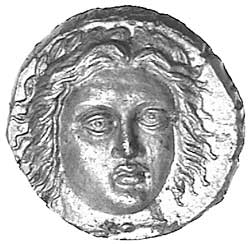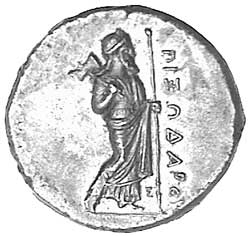Greek Silver & Bronze


Lot 1897 Greek Silver & Bronze
Estimate $5,000
Bid at live.noble.com.au
SOLD $4,500
CARIA, Pixodarus satrap, (340-334 B.C.), silver tetradrachm, (14.78 grams), obv. laureate head of Apollo three-quarter face to right, himation clasped at neck, rev. Zeus Labraundos standing to right holding double headed axe over shoulder and spear, to right **PIXWDAROU*, E above left foot, (cf.S.4966, SNG Von Aulock 8047, Traite 110, Pl.90, 18, NFA VIII, 1980 [lot 289 same dies]). Toned, extremely fine, very rare, and with trace of original mint bloom on the reverse, one of the finest examples known.
Ex. Sotheby's, Nelson Bunker Hunt collection, sold June 19-20, 1991 (lot 391, illustrated and realised US$ 3575) and Stack's, New York auction sale May 4, 1995 (lot 2081, illustrated in colour and the cover illustration with an estimate of US$3500-$4500). Pixodarus was the last male heir of the Hecatomnid dynasty in Caria. He came to power in the wake of two older brothers Mausolus and his successor Hidrieus, who are best remembered for the construction of Mausolus' spectacular tomb, the Mausoleum. Pixodarus' historical role is peripheral to the drama of the Macedonian succession. As Philip of Macedon was preparing for an invasion of Asia, Pixodarus sought an alliance by proposing a marriage between his daughter Ada and Philip's illegitimate son Arrhidaeus. Alexander, insecure in his father's favour sent the tragic actor Thettalus on a secret mission to Caria to advise Pixodarus of Arrhidaeus' mental incompetence and to offer his own hand instead. Philip discovered the plot and punished both Alexander and Thettalus. Pixodarus compounded his initial blunder after Philip's death, alighning himself with the Persian cause by marrying the same Ada to the satrap Orontobates. Pixodarus retained the coin types introduced by Mausolus. The obverse type, a frontal head of Apollo, was generally inspired by the facing head of Helios on the coinage of nearby Rhodes. However the choice of Apollo, patron of the arts, advertised the Hellenizing policies and cultural pretensions of Mausolus and his successors. The reverse honours Zeus of labraunda, a Carian deity who was worshipped at the original Hecatomnid capital of Mylasa.
Estimate / sale price does not include buyer's premium (currently 22% including GST) which is added to hammer price. All bids are executed on the understanding that the Terms & Conditions of sale have been read and accepted. For information on grading and estimates please refer to the Buying at Auction advice.
Quick find
View a lot by number and sale.
Adjacent lots
Lot 1895
CARIA, Cnidus, (390-330 B.C.), silver hemidrachm (1.18 grams), obv. head of Aphrodite to right hair ...
Estimate $80
Lot 1896
CARIA, Halicarnassos, (377 - 360 B.C.), silver hemiobols (Persic standard), (0.47 grams each), obv. head ...
Estimate $120
Lot 1897 This lot
CARIA, Pixodarus satrap, (340-334 B.C.), silver tetradrachm, (14.78 grams), obv. laureate head of Apollo three-quarter ...
Estimate $5,000
Lot 1898
CARIAN ISLANDS, Rhodes, (340-316 B.C.), silver didrachm, (6.6 grams), obv. head of Helios three-quarter face ...
Estimate $300
Lot 1899
PHRYGIA, Cadi, Claudius, (A.D. 41-54), AE 20, (4.0 grams), obv. laureated head of Claudius to ...
Estimate $100